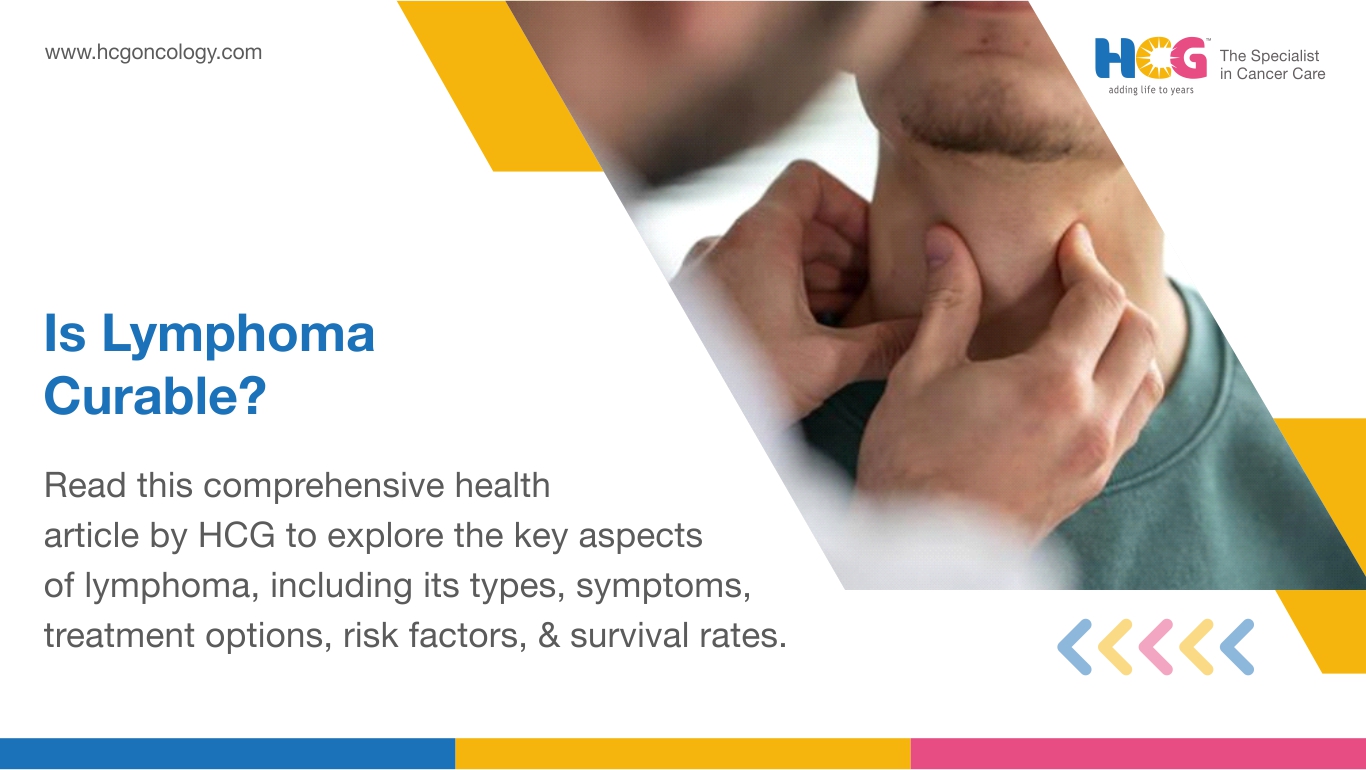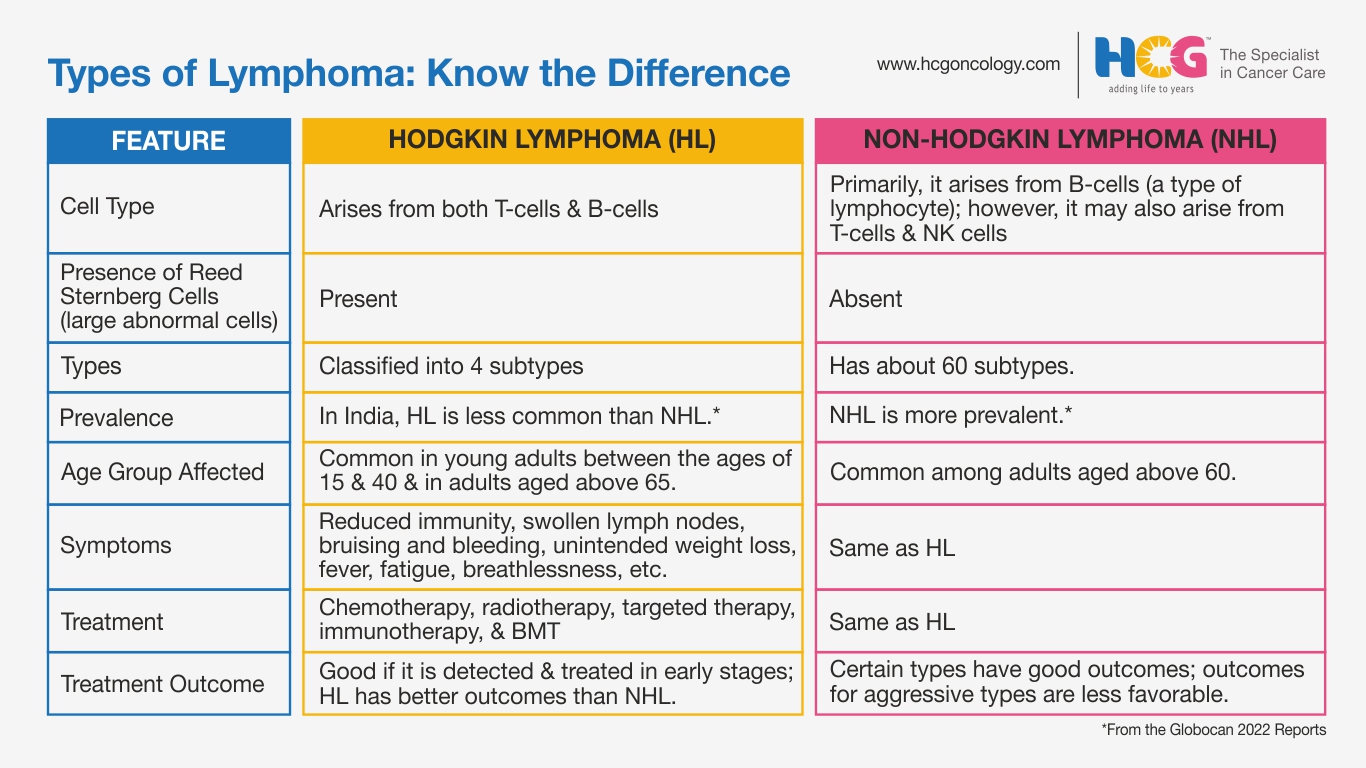
07 Nov, 2025
Feel free to reach out to us.

07 Nov, 2025

This article is medically reviewed by Dr. Joydeep Chakrabartty, Head of the Department and Senior Consultant - Hemato Oncology & BMT, HCG Cancer Centre, Kolkata.
Lymphoma is a type of cancer that develops in the lymphatic system and involves immune cells. These infection-fighting cells, called lymphocytes, can be found in various parts of the body, including lymph nodes, the thymus, the spleen, and bone marrow.
Cancer occurs when these cells grow out of control and undergo genetic changes.

Lymphomas are categorized into two broad groups: Hodgkin lymphoma (HL) and non-Hodgkin lymphoma (NHL). NHL is further classified into 60 subtypes.
Based on his observations of lymph node enlargement and other symptoms in lymphoma patients, a pathologist by the name of Dr. Thomas Hodgkin made the discovery of Hodgkin lymphoma in the 1800s.
Those with Hodgkin lymphoma have large, abnormal white blood cells called Reed-Sternberg (RS) cells. People with NHL don’t have these cells.
Non-Hodgkin lymphoma (NHL) affects more than 70,000 adults and children each year.
NHL comprises a varied group of 60 types of lymphomas, with two major subgroups: B-cell lymphoma and T-cell lymphoma. B-cell NHL is more common, accounting for about 80 percent of all cases.
Each type of NHL is treated differently based on the type of cancer cell and its rate of growth. In some cases, surgery is recommended for diagnostic purposes. Treatment may include chemotherapy, radiation therapy, and/or immunotherapy.
Hodgkin lymphoma, also known as Hodgkin’s lymphoma or HL, is a type of cancer that originates from the lymphatic system. It is charact erized by the presence of Reed-Sternberg cells.
Reed-Sternberg cells, also called Hodgkin cells, are large, atypical lymphocytes (a type of white blood cell) found within the lymph nodes. These cells may contain multiple nuclei and are found in people with Hodgkin lymphoma. The presence of Reed-Sternberg cells helps distinguish Hodgkin lymphoma from other types of lymphoma.
The key factors that influence lymphoma prognosis are:
Additional Reading: Lymphoma - The Most Common Type of Blood Cancer
The lymphoma cancer treatment success rate depends on factors like the stage of cancer, the patient’s age and overall health, and the response to treatment.
Survival varies significantly based on subtype and stage. Here's a general breakdown:
Hodgkin lymphoma generally has an excellent prognosis, especially when diagnosed early.
Signs and symptoms of lymphoma include:
The diagnosis and treatment of lymphoma are often multimodal.
Lymphoma diagnosis often begins with an exam that checks for swollen lymph nodes in the neck, underarm, and groin.
Other tests include imaging tests and removing some cells for testing. The type of tests used for diagnosis may depend on the lymphoma's location and your symptoms.
Common lymphoma cancer treatments include:
Lymphomas are usually considered treatable, and in many cases, patients can achieve long-term remission, too.
Lymphoma treatment success rates depend on several factors, including the type of lymphoma, the stage of the disease at the time it’s diagnosed, and the patient’s age and overall health.
Although lymphoma can occur in anyone, certain preventive measures may help one reduce their lymphoma risk:
Lymphoma is a complex group of blood cancers that develop in the lymphatic system and impact the immune system’s lymphocytes. It is mainly classified into Hodgkin lymphoma and non-Hodgkin lymphoma, each with various subtypes that differ in progression, treatment options, and prognosis.
“Is lymphoma completely curable?” is a commonly asked question. The answer depends on the type and stage. In many cases, lymphoma patients complete their treatment and enter long-term remission. However, in some cases, the disease may not respond to the treatment or relapse sometime after treatment completion.
When considering which type of lymphoma is more curable, Hodgkin lymphoma often has better outcomes, especially in early stages. Ultimately, whether lymphoma cancer is curable or not depends on factors like lymphoma type, stage at diagnosis, patient age, and response to treatment.

Dr. Joydeep Chakrabartty
Head of the Department and Senior Consultant - Hemato Oncology & BMT
MBBS, MRCP (UK), FRC PATH (UK), FRCP (Glasgow), CCT
Dr. Joydeep is an experienced hemato oncologist and BMT physician with over 20 years of experience in the diagnosis, treatment, and overall management of hematological disorders, such as leukemia, myeloma, lymphoma, and other blood disorders. He can be consulted at HCG Cancer Centre, a well-known cancer hospital in Kolkata. Dr. Joydeep’s primary interest lies in the areas of bone marrow transplantation (BMT), especially mismatched high-end transplants for all conditions, especially acute leukemias. He is very competent in the laboratory diagnostic part of hematological diseases. He is exceptionally skilled in critical care medicine, too.
Appointment Link: Book an Appointment with Dr. Joydeep Chakrabartty.